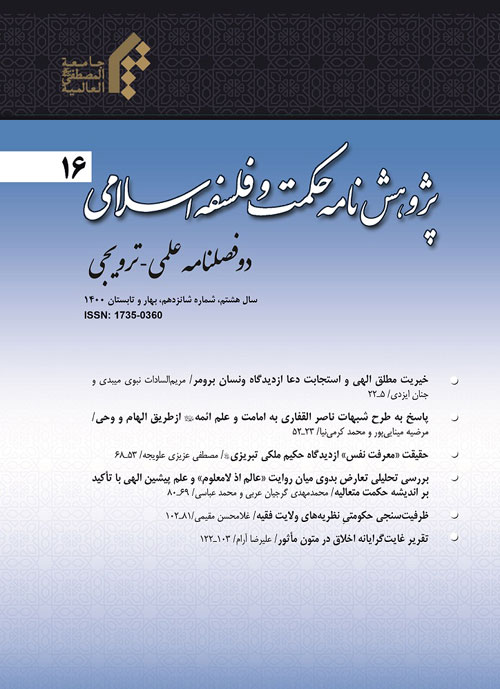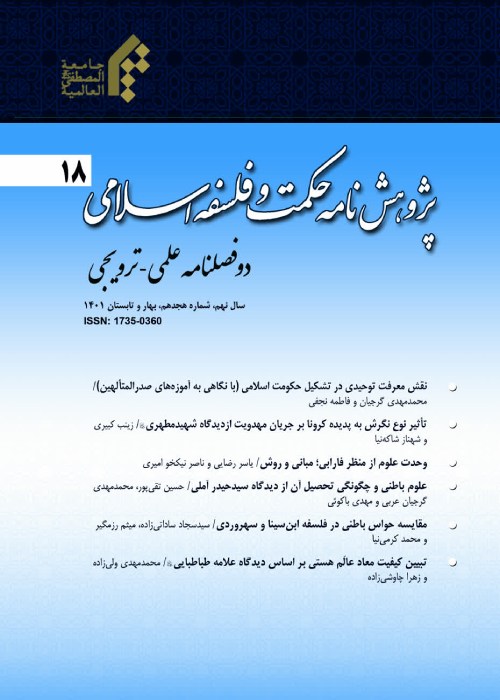فهرست مطالب

پژوهشنامه حکمت و فلسفه اسلامی
سال هشتم شماره 15 (پاییز و زمستان 1399)
- تاریخ انتشار: 1400/06/16
- تعداد عناوین: 6
-
-
صفحات 103-121
-
صفحات 121-139
-
Pages 5-25
Along with the origin of creation and prophethood, resurrection is one of the serious worries in the Islamic doctrines and what matters the most is how people shall be resurrected on the Day of Judgment. From among lots of issues about howresurrection, there is the question whether resurrection is merely spiritual or both physical and spiritual. Muslim philosophers have rationally dealt with the issue masterfully; you can find different theories from those who have refuted bodily resurrection to those who demonstrated it rationally. In his descriptive-analytic research, the author aims to explain the issue through Mulla Sadra’s demonstration of resurrection as the pioneer and founder of transcendent theosophy. Having used anthropological and ontological principles some of which he founded and some he approved, Mulla Sadra went to analyze and demonstrate the issue rationally. The key principles he made use of are: the primacy of existence, the individuation of existence, the graded spectrum of existence, the trans-substantial motion, the role of form and last differentia in the true reality of a compound entity, personal unity of existence, the role of mind in the body, the incorporeity of the imagination faculty, the role of mind in the forms of perception, the realization of the forms of imagination without the contribution of matter and that man encompasses the three worlds.
Keywords: philosophy, resurrection, Mulla Sadra of Shiraz, bodily resurrection, reason -
Pages 25-47
Consistency or inconsistency in the course of understanding texts and interpretation are one of the challenging issues in modern philosophy whose range covers legal discussions particularly the interpretation of legal texts by a judge. As per the Islamic school of thought which interprets legal texts on the pivot of the author or the text itself, the reader is seeking for the intended meaning of the author. Impressed by modern approach of the West, some modernist scholars have gone to hold that the customary method of understanding and interpretation fail to meet the needs of the new generation and the contemporary world. They have thus sought for modern thinking in legal texts and asked for new interpretation of the open texture of law according to the up-to-date demands. In what follows, the author has tried to analyze three key factors of positing the law in the light of Islamic thought: the author, the interpreter and the features of the legal texts. As per the celebrated Islamic thought and demands of legal divinity, the main law-maker is Allah Almighty and human institutes are given permission to make law only on some social affairs according to the faculty of reason. Contrary to the historical approach and hermeneutics that speak of open texture of legal texts, the interpreter of law seeks for the intended meaning by law-maker which is fixed and determined. Contrary to factual texts that express and describe outside realities, legal texts express the considerations of divine or human law-makers. Accordingly, the analysis of the essence of legal propositions, their subject predicate and judgment, matters the most. The method adapted for this research is descriptive-analytic.
Keywords: texts expressing the truth, legal text, the author, the interpreter, postulates -
Pages 47-87
In what follows, the authors have dealt with the relation between miracles and the law of causality. Having adopted a philosophical-theological method and in the framework of unknown causes and dominated or supernatural causes, they closely examine theories such as the incompatibility of miracles and causality or the denial of either of the two. Dealing first with the semantics of miracles, they sum up the issues of miracles and then propose issues about causality and the consequences of its denial. Having explained the two phenomena, they compare the relation between them. There are seven viewpoints studied in three phases: “the compatibility of miracles with causality”, “the incompatibility of miracles with causality” and the denial of any relation between miracles and causality”. By those seven theories, one may claim that all theories therein have been proposed for study. The room for any new inquiry on this issue is still open, though.
Keywords: miracle, the law of causality, western intellectuals, Muslim intellectuals, comparison -
Pages 87-103
A Muslim ruler has the highest position in an Islamic government over him nobody rules. A Muslim ruler, Shaikh Ishraq and Mulla Sadra argue, is the vicegerent of Allah on the earth. Since divine providence demands that the His vicegerent be present on the earth at all times, factually, there must be qualified people to rule over the earth each at every time. A close look into Shaikh Ishraq’s view suggests that an Islamic ruler in the majority of cases ought to be a prophet and must be perfect in his three faculties of rationality, imagination and sensation. In the minority cases, he says, the ruler can be a person in the highest taste of divinity and his unique gift in intellect makes him superior to rule. Mulla Sadra follows Shaikh Ishraq in that the ruler ought to be one individual person in his qualifications in the majority of cases and in the qualifications of a prophet. Nonetheless, since he introduced Imam as the qualified ruler after the prophet, in the minority of cases, Mulla Sadra holds, due to his knowledge of things the seen and the unseen, Imam deserve to be the ruler. He considers Imam’s knowledge of the unseen as the central qualification, though.
Keywords: Islamic ruler, Shaikh Ishraq, Mulla Sadra, prophet, godly sage, knower -
Pages 103-121
Salvation and redemption are one of the most important and far-reaching issue of different religions. After the definition of salvation i.e. man’s desired situation, the first question proposed for study is how to achieve that situation. There is some specific definition of salvation in every religion. All religions have come to rescue mankind from the current undesirable situation taking him into an ideal desirable one. They also study how to attain that desirable situation, yet to come. Indeed, all religions carry a message and call to all human beings in order to help them achieve salvation and redemption, the scale of such a message is the distance between the ongoing situation and the ideal one. Of course, the way how to invite and call people is different in different religions. Having examined Allamah Tabatabaii’s viewpoint through a descriptive-analytic method in their research, the authors go to draw the conclusion that religions are one with Allah without any discrepancy. The true faith is one identical divine tradition to meet man’s innate nature in the course of man’s demand for salvation and happiness. In its core unity, divine faith wears the clothes of multiplicity, since different specific faiths appeared through different prophets due to different capacities and interests of different societies in the course of their development. According to this view, all divine religions provided man with salvation in their particular time. Based on the faith and good deeds of their followers, all religions helped them achieve salvation and redemption.
Keywords: salvation, redemption, true faith, desirable situation, AllamahTabatabaii -
Pages 121-139
In their statement about the hereafter body, those who believe in bodily resurrection are classified into two groups: one group holds that resurrection is possible through earthy elements but another impossible so they believe in purgatory body. As to the bodily resurrection through earthy elements, either of the two ought to be proved: “the possibility of reincarnation” or “the endurance earthy elements”. Those who believe in reincarnation have no particular problem here, but those do not must prove the purgatory body theory and its endurance after death. Those who have denied both reincarnation and the endurance of earthy elements came to believe in the purgatory body theory. As to this issue, one ought to pay close attention to the tie between body and mind. Finally, it must be taken into consideration how far the proposed arguments correspond to the above claim. The arguments for the possibility of any picture, granted they are sound and valid, do not mean that the picture will happen.
Keywords: body of earthy elements, purgatory body, bodily resurrection, reincarnation, the body-and-mind relation


